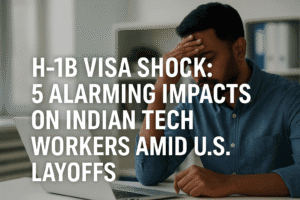H-1B Visa Shock: 5 Alarming Impacts on Indian Tech Workers Amid U.S. Layoffs
The Trump administration’s approval of 120,141 H-1B visas for FY2026 has sparked controversy amid ongoing U.S. tech layoffs, reigniting debates over foreign labor’s role in the industry. Indian professionals, who historically dominate H-1B allocations, face uncertainty as critics argue the visas displace American workers, despite claims of addressing specialized skill gaps. Political divides within the Republican Party highlight tensions between “America First” protectionism and corporate demands for global talent, with figures like Vivek Ramaswamy defending the cultural and innovative contributions of foreign hires.
While companies justify the demand for niche expertise in fields like AI, critics, including Elon Musk, propose reforms like higher salary thresholds to prioritize domestic workers. The decision underscores systemic challenges in U.S. tech education and workforce readiness, raising questions about long-term reliance on foreign labor. For India, reduced visa access could reshape its IT sector’s global footprint, potentially boosting domestic innovation but straining its outsourcing model. Ultimately, the H-1B debate reflects broader struggles to balance economic competitiveness, workforce equity, and globalization’s realities in an evolving tech landscape.

H-1B Visa Shock: 5 Alarming Impacts on Indian Tech Workers Amid U.S. Layoffs
The Trump administration’s approval of 120,141 H-1B visas for fiscal year 2026 has reignited debates over America’s reliance on foreign tech talent, even as the U.S. tech sector faces significant layoffs. This decision, juxtaposed against reports of over 50,000 tech job losses in early 2025, raises critical questions about labor dynamics, corporate priorities, and the future of global talent mobility—particularly for Indian professionals, who historically dominate H-1B visa allocations.
Understanding the H-1B Visa Context
The H-1B program allows U.S. companies to hire foreign workers in specialized roles, often in tech, engineering, and healthcare. Critics argue it displaces American workers, while proponents highlight its role in filling skill gaps. Indian nationals, renowned for their strong presence in STEM fields, typically account for ~70% of H-1B recipients, making them central to this debate.
The Paradox: Layoffs vs. High Visa Demand
Despite widespread layoffs at major tech firms, H-1B applications remain robust. This contradiction has fueled accusations from groups like US Tech Workers, who claim companies are prioritizing cheaper foreign labor over domestic hires. However, industry leaders counter that the visas address niche skill shortages (e.g., AI, cybersecurity) not easily met by the existing U.S. workforce.
Political Divides and the “America First” Dilemma
The Republican Party remains split. Protectionist factions, echoing Trump’s “America First” ethos, view the visas as a threat to U.S. jobs. Figures like podcast host Jack Posobiec argue, “We are not tech company first… We are American people first.” Conversely, voices like Indian-American entrepreneur Vivek Ramaswamy defend the cultural and innovative edge brought by foreign talent, stressing, “If we’re serious about fixing the problem, we have to confront the truth” about systemic gaps in U.S. tech education and training.
Indian Professionals: Opportunities and Uncertainties
For Indian workers, the H-1B remains a golden ticket to career advancement and global exposure. However, the program’s volatility under shifting administrations creates anxiety. Stricter scrutiny during Trump’s first term led to higher denial rates, and proposed reforms—like Elon Musk’s suggestion to raise minimum H-1B salaries—could further narrow opportunities. Meanwhile, India’s own tech sector faces pressure as its workforce navigates these policy winds.
Proposed Reforms and Long-Term Implications
Musk’s call to “make H-1Bs materially more expensive than domestic hires” reflects growing momentum to overhaul the program. Raising salary thresholds could deter cost-driven outsourcing but risks stifling innovation if U.S. talent pipelines remain underdeveloped. For India, reduced visa access might accelerate reverse brain drain, bolstering its domestic tech ecosystem but straining its export-driven IT services model.
The Road Ahead
The FY2026 visa cap, though lower than previous years, signals sustained reliance on global talent. Yet, the political climate suggests reforms are inevitable. Balancing economic competitiveness with workforce protectionism will define the U.S.’s approach—and determine whether Indian professionals continue to anchor America’s tech ascendancy or pivot to emerging opportunities elsewhere.
In this high-stakes interplay of policy and pragmatism, the H-1B debate transcends visas, touching on deeper themes of globalization, equity, and the evolving nature of work in an AI-driven age. For Indian professionals, adaptability—and advocacy—remain key.
You must be logged in to post a comment.